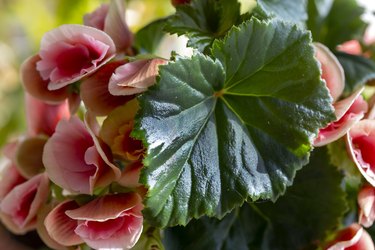
Gardening pros admit that tuberous begonias can be difficult to grow, but those lovely red, pink, orange, yellow and white blooms can be well worth the trouble. This flower is a high-maintenance plant known for its thick, underground tubers that store water and nutrients when the plants are dormant. They don't have fibrous root systems, but you can pull them up and store them until the growing season returns.
Types of Begonias
Video of the Day
Begonias are grouped into other categories as well. Wax begonias have fibrous roots, dark green leaves and clusters of single or double blooms in red, pink or white. The angelwing also has fibrous roots but is taller and canelike with small pink flowers. Beefsteak and rex begonias have rhizomatous root structures. They also have fascinating leaves and delicate, smaller flowers.
Video of the Day
Tuberous begonia plants produce boldly colored upright or cascading flowers and are the pickiest group to grow. Some of the better-known varieties are the bright and cheery Go Go Yellow and the double-flower Solenia Cherry. Consistent and appropriate tuberous begonia care is essential if you want these plants to produce lots of flowers.
What Is Wrong With My Begonias?
When do begonias bloom? They usually start sometime in June, and with proper care, they keep going until the first frost. They are sensitive to cold and won't do well in temperatures of 50 degrees Fahrenheit or below. Even though they are tropical plants that dislike hot, dry weather, the flowers and foliage will get damaged when the plants get too much sun. They do best with just four hours of morning sun and are also happy under high trees where they can enjoy the filtered light.
Tuberous begonias need well-draining soil whether they are grown in containers or gardens. The tuberous root system can rot if the soil is too wet; they need to dry out between watering and rainfall. You will want to use pots with drainage holes and fill them with humus-rich potting mix. Outdoors, the soil should have a 5.2 to 6.0 pH, which is on the more acidic side. If your garden begonias aren't doing well, test the soil and fertilize if needed; most of these plants can benefit from more nitrogen.
How to Keep Begonias Blooming
Signs of sick begonias include little or no flowers, rotten or dried-up roots, yellow and brown leaves or limp leaves. These can all be due to both overwatering and underwatering as well as too much sun or not enough sun. A powdery white growth could signal a fungal infection, while holes or brown dots on the leaves are indicative of pest infestations. You can treat these infestations with anti-fungal or pesticide applications in most cases. If the leaves are curling and the plant isn't growing, it may be time to add some fertilizer.
Water your tuberous begonias consistently but let the top 2 inches of soil get dry in between. Check the plants often when the weather is very hot, dry or rainy and never let water stand in container saucers. You can fertilize them about once a week with a quarter-strength liquid fertilizer to encourage more flower production. You can treat tuberous begonias like annuals, as the tubers can be pulled up after the growing season and stored in a cool place indoors for the following year's planting.